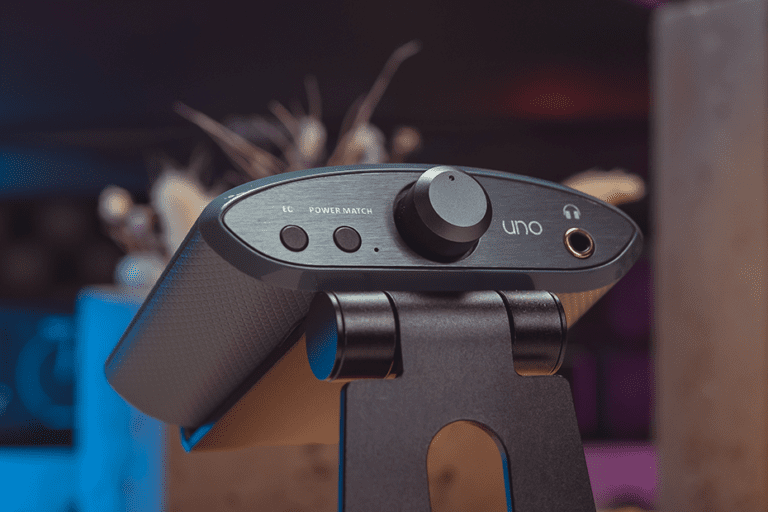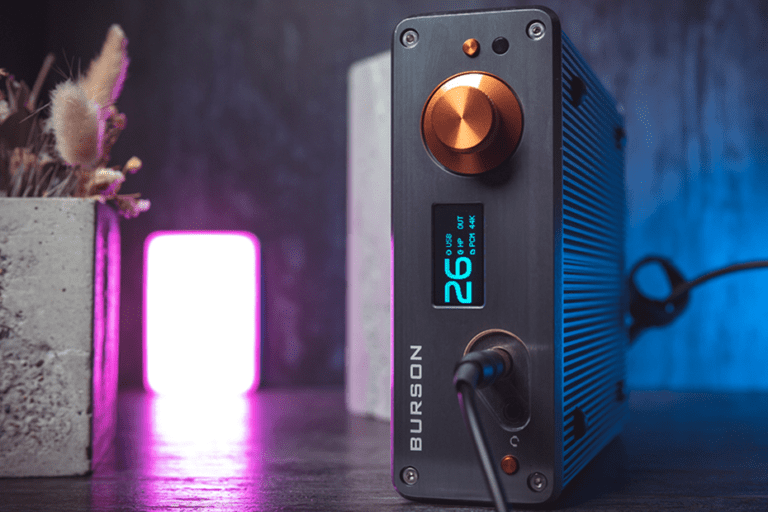
iFi Uno DAC & headphone amplifier review
In this review we take a look at the iFi Uno desktop DAC & headphone amplifier. Many thanks to iFi Audio for arranging the sample for today’s review. Much appreciated!
iFi Uno supports PCM decoding up to 384khz at 32 bits and also DSD256 and MQA. The device has one 3.5mm single-ended headphone output, 211 mW of output power @ 32Ω and three EQ curve presets. The Uno comes in a small carton box.
In the box:
- iFi Uno desktop DAC/AMP
- iFi sticker
- Quick start guide
- Warranty card
- User manual
- And a USB-C to USB-A cable
🛒 iFi Uno on Amazon
Design & build
The Uno is made out of plastic, but it’s also reinforced from both sides by brushed aluminum plates. The plastic is matte and feels solid. The device measures 88 by 81 by 26 mm and weighs just 92 grams, making it the tiniest desktop DAC/AMP I reviewed on my channel so far.
On the front, there is the EQ button, a power match button with a light indicator, a volume knob that is 15 mm in diameter, an audio format LED indicator located behind the knob, and a 3.5 mm single-ended headphone output with S-Balanced technology that reduces the channel cross-talk. Please refer to the official iFi website if you are interested in how this technology works.
There are RCA line outputs on the back of the device, a Hi-Res sticker, and a USB-C port. On the top of the unit, there is an etched iFi logo and three EQ preset light indicators.
On the bottom of the unit – two long rubberized feet that help keep the unit from sliding on your desk when you connect or disconnect your headphones or turn the volume knob.
Technical specifications
The Uno is based on the ESS ES9219MQ/Q chip that supports PCM decoding up to 384khz at 32 bits, DSD256, and also MQA.
THD is less than ≤0.02%, the dynamic range is 115 dB and the SNR ratio is 115 dB as well. According to the specs, the maximum output power is 211mW @ 32Ω and 39mW @ 300 Ohms so Uno has enough power for many full-size headphones, let alone the IEMs.
I was mainly testing it with my desktop PC running Windows 10 and my Apple MacBook Air running Sonoma 14.1.2.
I used FLAC and DSD files with Roon, and Apple Music and Tidal for lossless streaming. Setting up the Uno is a breeze. You just plug it in, turn it on, connect your headphones, and you’re ready to go.
Enjoying this review? Read more DAC/AMP reviews here
Now a few words about functionality
The PowerMatch button is a gain switch that helps to match iFi Uno to the impedance and sensitivity of your IEMs or headphones. In simple words, it’s a gain switch.
The iFi recommends using Low-gain mode (Power match off) for IEMs and hi-gain mode (power match engaged) with full-size headphones.
The volume knob is very smooth and I found it very comfortable to use. The knob also serves as an on/off switch when completely turned down.
The LED around the volume knob changes the color according to the file format. The color schemes are explained in the quick-start guide but here it is just in case.
It’s also important to note that the volume knob controls the volume of the RCA line output on the back too. In my case, this was useful, as I’m used to controlling my powered studio monitors directly from my audio interface.
But, the RCA output of Uno is constantly on, so even if you connect the headphones it’s not switched off and this wasn’t very suitable in my scenario with powered studio monitors.
The EQ button rotates through 4 EQ modes – EQ off, music, movies, and gaming. The EQ is done in the analogue domain which is a huge plus.
The gaming mode boosts the bass and the upper midrange from 4 to 5 kHz. The movie mode slightly boosts the bass and upper midrange from 2 to 3 kHz. The music EQ profile just slightly boosts the bass, leaving the upper midrange intact. Overall such a basic EQ is a nice addition to the functionality.
At the time of making this video, there were three versions of Uno firmware available – V1.87, V1.89, and V2.4. All tests have been performed with the firmware version 2.4
iFi Uno pairings & sound impressions
With all of my IEMs, I have run the unit in the low-gain mode and rarely increased the volume past 2 PM. At the same time, I didn’t notice any audible distortion or noise with sensitive IEMs which is good.
The next important aspect for me was how it would drive my full-size headphones. I tried it with many of my full-size headphones while making this review. All full-size headphones have been tested using the hi-gain mode (so the PowerMatch button was engaged).
The Uno has driven everything in the 16 to the 150-ohm range just fine (except for maybe AKG K612) and I had enough headroom left.
Switching to headphones that have 250 and 300 Ohm of impedance left me with almost no headroom, so the results have been mixed, especially with quiet recordings. But that’s based on my preferred levels of volume and my preference to always have some headroom in case I need it, so please take what I’ve just said with a grain of salt.
So what do I like about this device?
- Affordable pricing
- Good design and build
- The on/off switch is very handy
- RCA line-out is controlled with a volume knob
- S-Balanced 3.5mm connection
- Two gain modes
- Enough power to drive a lot of full-size headphones, let alone the IEMs
- And a musical and warm sound signature
What I didn’t like?
Well, this unit has no real cons. But if you want me to be very picky, I’d say that I would prefer to see a fully metal volume knob and if the line-out output was muted automatically upon the headphone connection. And that’s it.
The Uno is an ideal desktop companion for headphones and IEMs in the 16-250 Ohm range (with some exceptions of course) and it pairs well with bright and neutral bright headphones.
Uno also strikes the perfect balance between price, performance, and output power in a small and beautiful form factor. And if you are new to the headphone game, it makes it a great first desktop DAC/AMP. Unless you already own a pair of very demanding and hard-to-drive headphones.
🛒 iFi Uno on Amazon
And that concludes my review for today. If you want to see more content like this, consider subscribing to my YouTube channel for future updates. Thank you for joining me, and until next time, goodbye!



